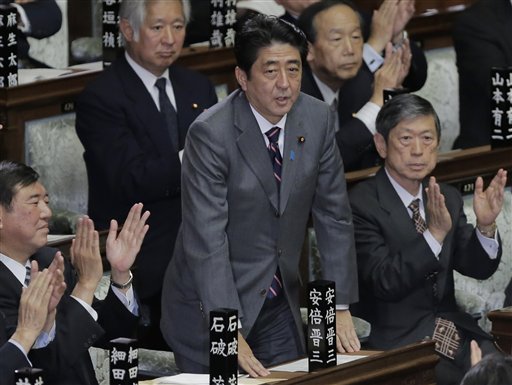(AP) Shinzo Abe returns as Japan’s prime minister
By ERIC TALMADGE
Associated Press
TOKYO
Old-guard veteran Shinzo Abe was voted back into office as prime minister Wednesday and immediately named a new Cabinet, ending three years of liberal administrations and restoring power to his conservative, pro-big-business party that has run Japan for most of the post-World War II era.
Abe, whose nationalist positions have in the past angered Japan’s neighbors, is the country’s seventh prime minister in just over six years. He was also prime minister in 2006-2007 before resigning for health reasons that he says are no longer an issue.
The outspoken and often hawkish leader has promised to restore growth to an economy that has been struggling for 20 years. His new administration also faces souring relations with China and a complex debate over whether resource-poor Japan should wean itself off nuclear energy after last year’s earthquake and tsunami caused a meltdown at an atomic power plant.
On top of that, he will have to win over a public that gave his party a lukewarm mandate in elections on Dec. 16, along with keeping at bay a still-powerful opposition in parliament. Though his party and its Buddhist-backed coalition partner is the biggest bloc in the more influential lower house, Abe actually came up short in the first round of voting in the upper house, then won in a runoff.
Capitalizing on voter discontent with the left-leaning Democratic Party of Japan, Abe has vowed to shore up the economy, deal with a swelling national debt and come up with a fresh recovery plan following last year’s tsunami disaster, which set off the worst nuclear crisis since Chernobyl.
In foreign policy, Abe has stressed his desire to make Japan a bigger player on the world stage, a stance that has resonated with many voters who are concerned that their nation is taking a back seat economically and diplomatically to China.
He has said he will support a reinterpretation of Japan’s pacifist postwar constitution to loosen the reins on the military, stand up to Beijing over an ongoing territorial dispute and strengthen Tokyo’s security alliance with Washington. Beijing has already warned him to tread carefully, and will be watching closely to see if he tones down his positions now that he is in office.
Abe led the Liberal Democratic Party to victory in nationwide elections this month to cement his second term as Japan’s leader.
His new Cabinet will feature another former prime minister, Taro Aso, as finance minister. Heading the foreign ministry is Fumio Kishida, an expert on the southern island of Okinawa, where many residents angry over crime and overcrowding want a big reduction in the number of U.S. troops they host _ now at about 20,000. The new defense minister is Itsunori Onodera, who was in Abe’s previous administration.
Abe has already named a roster of top party executives that includes two women _ more than in previous LDP administrations _ and is younger than earlier ones, with three of the four in their 50s.
The LDP governed Japan for decades after it was founded in 1955. Before it was ousted in 2009, the LDP was hobbled by scandals and problems getting key legislation through a divided parliament.
This time around, Abe has promised to make the economy his top priority and is expected to push for a 2 percent inflation target designed to fight a problem that was until recently relatively unique in the world _ deflation. Continually dropping prices deaden economic activity, and the Japanese economy has been stuck in deflation for two decades.
Besides generous promises to boost public works spending _ by as much as 10 trillion yen ($119 billion), according to party officials _ Abe is pressuring the central bank to work more closely with the government to reach the inflation target.

COMMENTS
Please let us know if you're having issues with commenting.